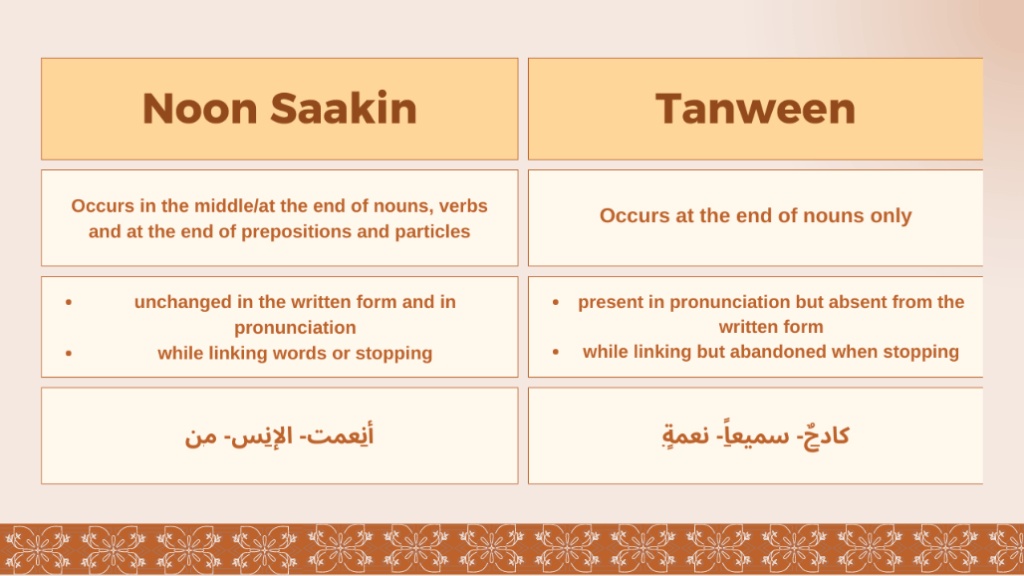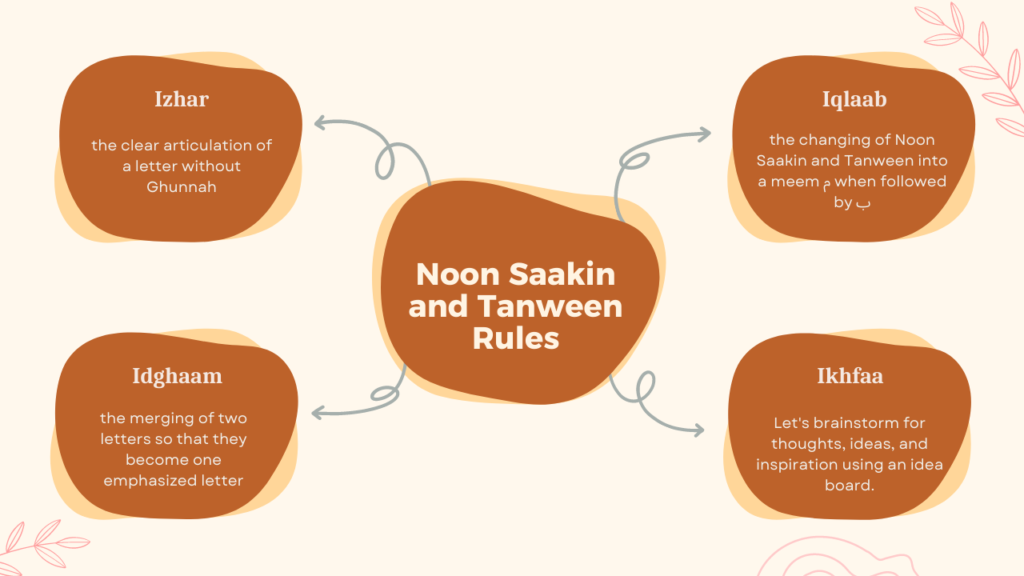The Prophet (PBUH) said, “The one who was devoted to the Qur’an will be told on the Day of Resurrection: ‘Recite and ascend (in ranks) as you used to recite when you were in the world. Your rank will be at the last Ayah you recite.’” [Abu Dawud and At- Tirmidhi].
To understand Noon Saakin and Tanween rules, it is essential to give a clear definition for both.
What is Noon Saakin?
Noon Saakin is a Noon that is free from any vowel and occurs in nouns and verbs (in the middle or at the end) in addition to prepositions and particles (at the end only). These are some Noon Saakin examples in Qur’an:
وقال الإنْسان مالها- وأما منْ خفت موازينه
What is Tanween?
On the other hand, Tanween is similar to Noon Saakin in terms of pronunciation; however, Tanween occurs only at the end of nouns and it is not written as Noon Saakin. Tanween is pronounced like Noon Saakin in case of linking as made clear in these Tanween examples:
أليس ذلك بقادرٍ على أن يحيي الموتى- عبداً إذا صلى- وهذا ملحٌ أجاج
With the previously mentioned Noon Saakin and Tanween examples in mind, it could be inferred that they share some qualities but differ in others as follows:

Rules of Noon Saakin and Tanween
Four essential Tajweed rules for Noon Saakin and Tanween are applied to both of them while reciting Qur’an:
- Izhar
- Idghaam
- Iqlaab
- Ikhfaa
Below is the explanation of Noon and Saakin and Tanween rules in English together with examples from the Qur’an to clarify the cases for each one:

1. Izhar Rule
The linguistic definition of the word “Izhar” is revealing something or making something clear but what is Izhar in Tajweed?
Izhar in Tajweed refers to the clear articulation of a letter without Ghunnah and such is the case with Noon Saakin and Tanween when either is followed by one of the Izhar letters (otherwise known as “Huroof Halaqiyya” or throat letters). These letters include: (ء – هـ – ع – ح – غ – خ).
Izhar examples
If Noon Saakin is followed by one of these Izhar letters in one word or between two words, we apply the rule of Izhar as in:
(فصل لربّك وانْحر)- (فسينْغضون إليك رؤوسهم)
(وما منْ غائبة في السماء والأرض إلا في كتاب مبين)- (إنْ هو إلا عبد)
Similarly, when Tanween is at the end of a word and the next word begins with one of the Izhar letters, it is also a case of Izhar such as:
(يقول الإنسان يومئذٍ أين المفر)- (ومن شر غاسقٍ إذا وقب)- (عبداً إذا صلى)
2. Idghaam Rule
Idghaam in Arabic refers to the process of merging or insertion and when it is applied in Tajweed in connection with Noon Saakin rules, it refers to the merging of two letters so that they become one emphasized letter. The same thing happens to Noon Saakin and Tanween when they are followed by one of the letters grouped in the word: يرملون
However, this act of merging or insertion is divided into two groups with specific cases for each one:
A) Idghaam with Ghunnah
Out of the six letters of Idghaam, only four which make up the word ينمو create what is known as Idghaam with Ghunnah. This takes place when the Noon Saakin and Tanween come at the end of a word and the first letter of the following word is one of the four letters (ي – م – ن – و). Unlike Izhar, Noon Saakin and Tanween are not articulated, rather, they are merged into the next letter along with Ghunnah or nasalization for 2 beats.
Idghaam Noon Saakin Examples:
فمن يعمل مثقال ذرة خيراً يره- والله من ورائهم محيط- ولن نشرك بربنا أحدا
Idghaam Tanween Examples:
وجوهٍ يومئذٍ ناعمة- جزاءاً من ربك عطاءاً حسابا- قل إني لا أملك لكم ضراً ولا رشدا
*Exceptions:
1. When Noon Saakin precedes one of these four letters within one word rather than in two, it is a case of Absolute Izhar where Noon Saakin is not merged into the following letter. There are only four examples of this exception in the Qur’an where Noon Saakin is followed by either و or ي within one word:
دنْيا- صنْوان- قنْوان- بنْيان
2. Another exception to this rule is found when Noon Saakin is followed by و in verses like:
يس وَالْقُرْآنِ الْحَكِيم
ن وَالْقَلَمِ وَمَا يَسْطُرُونَ
When the reader continues to read after سين and نون, the noon Saakin is not merged into و after it. Instead, it is articulated clearly without Idghaam.
B) Idghaam without Ghunnah:
This leaves two letters from the word يرملون which are (ل-ر). Unlike Idghaam with Ghunnah, when these two letters come after Noon Saakin and Tanween, they are completely merged into them with no Ghunnah. This is also known as Complete Insertion without Ghunnah. Here are some examples:
وما هو إلا ذكرٌ للعالمين- إن في ذلك لعبرةً لمن يخشى- غفوراً رحيماً
كلوا من رزق ربكم- ولم يكن له كفواً أحد- من لدنا
3. Iqlaab Rule:
Apart from Izhar and Idghaam, Iqlaab is another Tajweed rule to bear in mind concerning Noon Saakin and Tanween. Equivalent to its linguistic meaning, Iqlaab in Tajweed refers to the changing of Noon Saakin and Tanween into a meem م when followed by ب. This change is accompanied by two things; the Ghunnah and hiding of the meem. In the following verse:
لله الأمر من قبل ومن بعد
Noon Saakin at the end of the word من is followed by ب in the word بعد. Here, you are required to do the aforementioned steps; change the Noon Saakin into a hidden meem in addition to the Ghunnah. Other examples for Iqlaab include:
ينبؤ الإنسان يومئذٍ بما قدم وأخر- كرامٍ بررة
إذ انبعث أشقاها- كلا لينبذن في الحطمة
4. Ikhfaa Rule:
The final rule of Noon Saakin and Tanween is Ikhfaa. Linguistically, Ikhfaa is contrasted with Izhar since it means hiding or concealing. In Tajweed, it occurs when Noon Saakin or Tanween are followed by one of the remaining fifteen letters found in this mnemonic:
صف ذا ثنا كم جاد شخص قد سما
دم طيباً زد في تقى ضع ظالما
Ikhfaa is applied through the pronunciation of Noon Saakin and Tanween in a way that is between Izhar and Idghaam with Ghunnah on the first letter as in:
إن الإنسان لفى خسر- من شر ما خلق- قال رب انصرني بما كذبون
عذاباً قريباً- كتبٌ قيمة- بشرٌ تنتشرون
Rules of Noon Mushaddad
Aside from the previously mentioned Noon Saakin rules, it is of equal importance to explain the meaning of Noon Mushaddad and how it should be properly read while reciting the Qur’an.
Noon Mushaddad is the result of combining two Noons, the first is Saakin (without Fatha, Dummah or Kasrah) and the second is with one of them such as:

If this Noon Mushaddad occurs in a word, Ghunnah of 2 beats is required. These are some examples from the Qur’an of Noon Ghunnah in Arabic:
إنَّ الأبرار لفي نعيم- ثم لتسئلنَّ يومئذ عن النَّعيم
Conclusion:
Let’s recap some important points about the rules of Noon Saakin and Tanween through the following verse:

- First is Idghaam with Ghunnah in (فمن يكفر) as Noon Saakin at the end of the first word is followed by ي. Therefore, Noon Saakin must be merged into it with Ghunnah of 2 beats.
- Second is Iqlaab in (ويؤمن بالله) since the second word starts with ب so the Noon Saakin changes into م with Ghunnah and Ikhfaa.
- Third is Ikhfaa in (انفصام) because the letter ف is one of the Ikhfaa letters.
- Fourth is Izhar in (سميعٌ عليم) where Tanween came before one of the Izhar letters ع so it was articulated clearly without Ghunnah.
These were the most important things you need to know about the rules of Noon Saakin and Tanween.
Almuhammadi Academy is one of the best online Quran schools in the Muslim world nowadays, we have the best team of Online egyption Quran teachers who graduated from Alazhar university, they will help you or your kids to get closer to your goal of learning Tajweed and beautify your recitation of the book of Allah.


